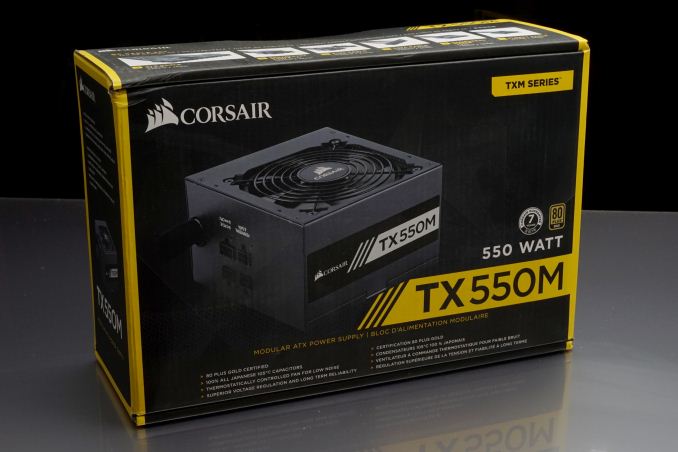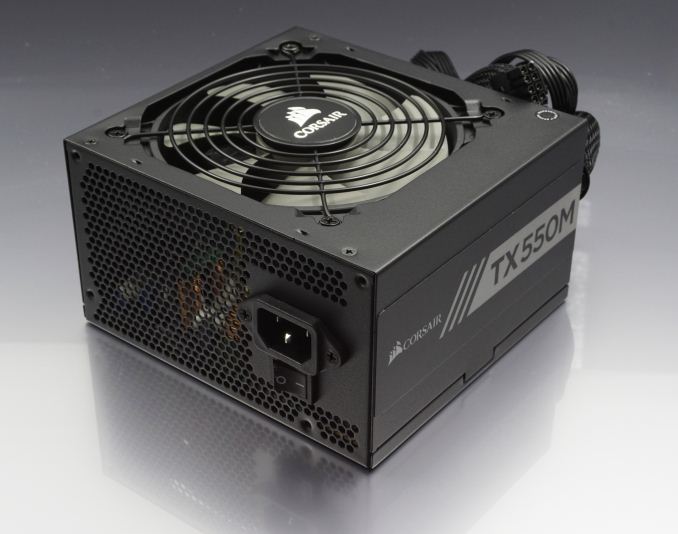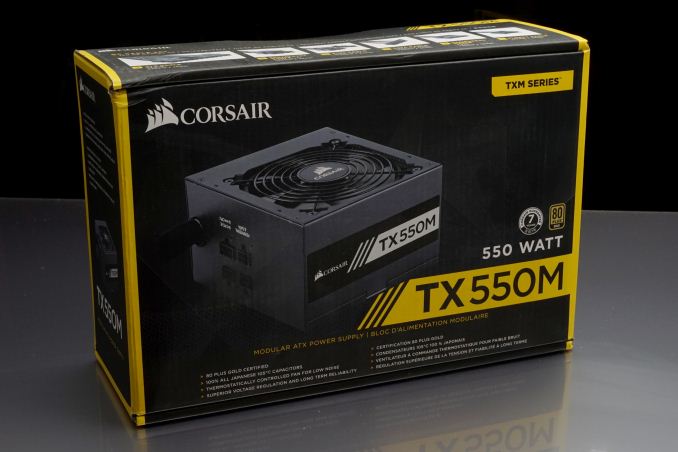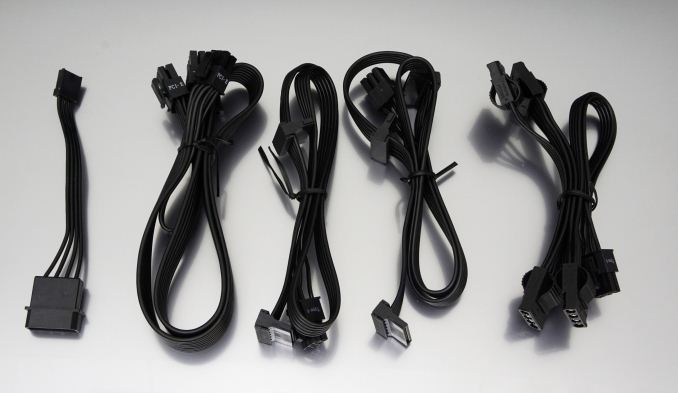The $80 Power Supply for Almost Everyone: The Corsair TX550M 80Plus Gold PSU Review
by E. Fylladitakis on December 1, 2017 8:00 AM EST- Posted in
- Cases/Cooling/PSUs
- Corsair
- PSUs
- 550W
- TX
- Modular
- Power Supply

Corsair started off as a high-performance computer memory manufacturer, but they evolved into one of the largest and most recognizable companies in the consumer PC market. Today the company markets an immense variety of products, including practically everything short of motherboards and processors. One of their most popular product ranges is that of power supply units (PSUs). The company released their first few PSUs back in 2006 but today they are offering a vast variety of products for every kind of user and application.
A few weeks ago we had a look at the HX850, one of Corsair’s better PSUs, a product designed for advanced gaming/workstation systems. Impressive as it was, its power output (and price tag) undoubtedly was excessive for the average home user and casual gamer. With PSUs, bigger is not better; using a PSU that is excessively overpowered will force it to operate well outside its optimal loading range, effectively reducing its efficiency and performance.
The optimal power range for a typical home entertainment/gaming system usually is within 400-600 Watts. To that end, Corsair supplied us with the TX550M, a PSU that the company feels it is ideal for the mainstream gamer.
| Power specifications ( Rated @ 50 °C ) | |||||
| AC INPUT | 100 - 240 VAC, 50 - 60 Hz | ||||
| RAIL | +3.3V | +5V | +12V | +5Vsb | -12V |
| MAX OUTPUT | 25A | 20A | 43A | 3A | 0.8A |
| 120W | 516W | 15W | 9.6W | ||
| TOTAL | 550W | ||||
On paper, it certainly does look that way - it has the ideal power output for a single-GPU card gaming system, impressive performance specifications, a 7-year warranty, and a very reasonable ($80) price tag.
Packaging and Bundle
We received the TX550M in a cardboard box that was peculiarly small in comparison to that of other Corsair products. Still, the cardboard box is strong enough to protect the PSU during shipping. The artwork is based on the same yellow/black that Corsair has been using for the past several years, with a picture of the PSU being the focus of it at the front of the package. A lot of information is printed on the sides and rear of the box.
The bundle of the TX550M is unsurprisingly simple. Inside the box we found only the typical AC power cable, black 3M mounting screws, a standard manual, a case badge, and a few short cable ties. Corsair does not supply any thumbscrews, cable straps, or other accessories.
The TX550M is a semi-modular PSU, meaning that the basic 24-pin ATX and 4+4 pin CPU power cables are hardwired to the unit but the rest of the cables are removable. All of the modular cables are flat, ribbon-like, with all-black wires and connectors. The same goes for the 4+4 pin CPU power cable that is hardwired to the unit. The 24-pin ATX cable is an exception, with all-black wires that are wrapped inside a classic black nylon sleeve.
| Corsair TX550M | ||
| Connector type | Hardwired | Modular |
| ATX 24 Pin | 1 | - |
| EPS 4+4 Pin | 1 | - |
| EPS 8 Pin | - | - |
| PCI-E 6+2 Pin | - | 2 |
| PCI-E 8 Pin | - | - |
| SATA | - | 5 |
| Molex | - | 4 |
| Floppy | - | 1 |
Recent Power Supply Reviews
AnandTech tests a good number of power supplies each year, mostly in the popular power ranges (650-850W) with a few reviews now-and-again for small form factor parts or larger behemoths. Here are the power supplies we have reviewed in the last twelve to eighteen months.
- [link] The Corsair TX550M 80Plus Gold PSU Review (this review)
- [link] The Corsair HX850 80Plus Platinum PSU Review
- [link] The Seasonic PRIME Titanium PSU (650W, 750W, 850W) Review
- [link] The Riotoro Onyx Power Supply Review: 650W & 750W Tested
- [link] The BitFenix Whisper M 450W & 850W PSU Review
- [link] The Silverstone ST30SF & ST45SF SFX Power Supply Review
- [link] The Zalman ZM1200-EBT 1200W Power Supply Review
- [link] The Be Quiet! SFX-L Power 500W PSU Review
- [link] The Enermax Revolution SFX 650W PSU Review
- [link] The SilverStone SX700-LPT SFX 700W PSU Review














42 Comments
View All Comments
Yuriman - Friday, December 1, 2017 - link
I'd argue that most home PCs without discrete graphics card are more in the 125-175w range, and many of those with lower end discrete cards (e.g. 1050 Ti) are still coming in under 200w, yet it's rare to find any company offering power supplies that cater to this market. Maybe the casual-use desktop is dead in the ATX form factor? Is everyone using NUC / micro PC / laptops instead?Yuriman - Friday, December 1, 2017 - link
I can't imagine power supplies being particular efficient in machines which idle at 5% of their total capacity, and torture test at less than 40%.A5 - Friday, December 1, 2017 - link
To answer your last question - yeah, the casual-use desktop is basically dead for home users. The big OEMs all still make some for businesses and the few people who want them, but they also right-size the PSUs on custom-order.Jhlot - Friday, December 1, 2017 - link
Exactly I am a light gamer (1050 Ti class) at this age and with time constraint of having young kids. I want a gold rated modular 300w supply at a reasonable price. They don't exist.leetcrew - Friday, December 1, 2017 - link
why even care about the efficiency rating on such a low draw machine? the difference between base 80plus and 80plus gold is 10% efficiency at 50% capacity. this is a delta of ~20W at load. if you live in the US, you would have to play for ~400 hours before you paid another dollar on your electric bill.t.s - Saturday, December 2, 2017 - link
Well, he is not like you sir. And I glad we still have someone like that around.DanD85 - Friday, December 1, 2017 - link
Because the maximum efficiency of a psu can only be reached when it runs at 50% load.Yuriman - Friday, December 1, 2017 - link
A 65w CPU + 75w video card + system components would be just over 50% load for a 300w unit when loaded. Case in point, my 5 year old Core i5 system with 1050 Ti draws between 150 and 175w while gaming.StevoLincolnite - Saturday, December 2, 2017 - link
Don't forget that Ram, Motherboard, Hard/Optical drives, USB devices and so on all consume power as well.t.s - Saturday, December 2, 2017 - link
Don't forget that Ram, Motherboard, Hard/Optical drives, USB devices and so on all consume < 30 watt.